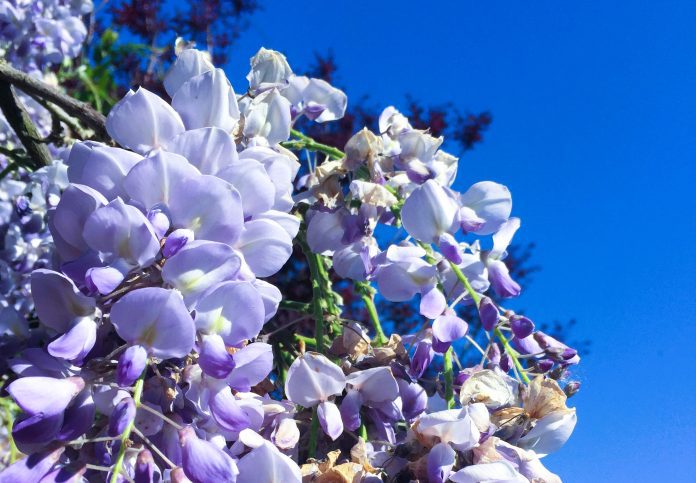Wisteria, with its cascading clusters of violet, blue, or white flowers, is a favorite climber in UK gardens. However, without proper care, it can become overgrown, producing more foliage than flowers. Pruning is essential for controlling its growth and ensuring a stunning floral display. In this guide, we’ll cover the when and how of pruning wisteria, with a focus on the UK’s climate.
When to Prune Wisteria
Wisteria requires pruning twice a year—once in summer and once in winter. Each pruning session serves a different purpose and is crucial for the plant’s health and floral production.
1. Summer Pruning (July to August)
After the wisteria’s main flowering period, usually around May or June, the plant’s growth becomes vigorous, sending out long shoots that need to be tamed. Summer pruning keeps the plant neat and ensures more sunlight reaches the stems, promoting better flowering next year.
- Why Prune in Summer?
Summer pruning controls the excessive leafy growth, preventing the wisteria from becoming too sprawling. It directs the plant’s energy towards bud formation rather than unnecessary vegetative growth. - How to Prune in Summer:
- Wait until the flowers have faded.
- Identify the long, whippy shoots that have developed since spring.
- Cut these shoots back to about 5-6 leaves from their base. This encourages the development of flowering spurs.
- If your plant is very vigorous, you can shorten these shoots further, cutting them to 2-3 leaves from the base.
2. Winter Pruning (January to February)
Winter pruning is essential to tidy up the plant and to encourage strong flowering the following season. This is done when the plant is dormant, making it easier to see the structure of the plant and plan the cuts accordingly.
- Why Prune in Winter?
Winter pruning focuses on enhancing flower production by removing dead wood and ensuring that the remaining buds are set for flowering. - How to Prune in Winter:
- Remove any dead, damaged, or crossing branches to improve the plant’s structure.
- Shorten the summer-pruned shoots further, cutting them back to 2-3 buds from the main stem.
- These buds will develop into flowering spurs, so make sure not to cut too far back, or you’ll risk losing flowers.
- Clear any tangled or overcrowded growth that could block light from reaching the flowering shoots.
How to Prune Wisteria: Step-by-Step Guide
- Gather Tools:
You will need a pair of sharp, clean secateurs and, for thicker branches, loppers or a pruning saw. Make sure your tools are sterilized to prevent the spread of disease. - Identify What to Prune:
Start by removing dead or diseased branches, followed by cutting back excessive or tangled growth. Aim to retain a strong framework of branches that will carry the flower spurs. - Cut the Whippy Shoots:
These shoots are often the first to be pruned. In summer, cut them back to 5-6 leaves. In winter, reduce them to 2-3 buds. - Focus on Structure:
Make sure the plant is balanced, with evenly spaced branches. Wisteria can grow aggressively, so regular pruning is essential for preventing it from becoming too top-heavy. - Train New Growth:
If you’re training your wisteria on a wall or pergola, tie new shoots to your support structure. This will help direct the plant’s growth and allow for a more organized appearance.
Pruning Wisteria for Different Structures
- Wisteria on Pergolas:
When growing wisteria on a pergola, pruning is especially important to maintain a controlled and elegant display. Focus on trimming back the shoots that grow away from the structure, and train side shoots along the pergola beams to encourage a uniform spread of flowers. - Wisteria on Walls:
Wall-trained wisteria can easily become unruly if left unchecked. Prune regularly to prevent the plant from becoming top-heavy. Encourage horizontal growth by tying in lateral shoots, which will help create a wall of flowers in the spring.
Tips for Successful Pruning
- Be Patient:
Wisteria can take a few years to flower, especially when young. Consistent pruning is key to establishing a healthy structure and encouraging blooms. - Avoid Over-Pruning:
While pruning is essential, cutting back too much can delay flowering. Be careful not to remove too many buds, particularly during winter pruning. - Feed and Water:
After pruning, give your wisteria a high-potassium feed to promote flower production. Water thoroughly during dry periods, particularly in spring as flower buds develop. - Check for Suckers:
Wisteria often produces suckers from its rootstock, which can sap energy from the main plant. Remove any suckers that appear around the base of the plant.
Final Thoughts
Pruning wisteria is an ongoing task that, if done correctly, will reward you with a spectacular display of blooms year after year. In the UK, the combination of summer and winter pruning is essential for controlling the plant’s growth and maximizing its flowering potential. With the right technique and timing, your wisteria can become the star of your garden!




